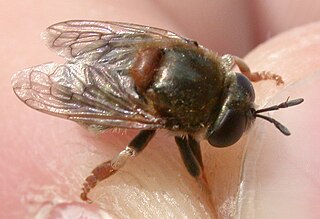
Hover flies of the genus Microdon are unusual among the Diptera. Like other members of the subfamily, they are myrmecophiles, meaning they inhabit the nests of ants.

Xylota is a Holarctic genus of hoverflies similar in structure to the related genera Chalcosyrphus and Brachypalpoides. As the larvae are saprophytic they're usually found in rotting wood. The adult flies are generally associated with woodland and woodland edges and can often be seen running over the upper sides of leaves. Unlike other syrphids the adults of many species rarely visit flowers preferring instead to gather pollen from leaf surfaces. There are over 100 described species of which 12 can be found in Europe. Seven species have been recorded in Britain. Identification of species has been difficult and identifiction by photographs is risky.

Cheilosia is a genus of hoverfly. Most Cheilosia are black or largely un-coloured, lacking the bright colours and patterns of many hoverfly species. It is one of the most species diverse genera of hoverflies. The biology of many species is little understood, but where known, the larvae of Cheilosia species feed in the stems of plants or in fungi.

Platycheirus is a large genus of hoverflies. They are also called sedgesitters.

Melanostoma is a large genus of hoverflies. Little is known of their biology, but they are suspected to be general predators of small insects in leaf litter.

Criorhina is a genus of hoverflies. Medium to large sized species, black or greenish black, with or without light ground markings mimicking bumblebees. The head is much flattened and broader than the thorax. The antennae are situated upon a prominent conical frontal process, The face is moderately produced below the eyes, downward or forward, in profile. The eyes are bare. The abdomen is elliptical or very short oval. Larvae found in rot holes or decaying hardwoods
Argentinomyia is a small genus of hoverflies.

Copestylum is one of the largest genera of hoverflies in the Americas. It comprises more than 300 species, of which only four have been found outside the Americas, having probably been introduced by the importation of cacti in which the larvae live.

Ocyptamus is a large and diverse genus of over 200 species of hoverfly mostly found in the Neotropical region. It is likely that many of these species will be discovered to be synonyms though many others await description.

Palpada is a genus of 85 neotropical and nearctic flower flies or hoverflies This genus is often colorful and bee-like. It is in the tribe Eristaliini containing dozens of genera Common sister genera include Eristalis (99 species), Meromacrus (43 sp.), Eristalinus (100 sp.) and Helophilus (50 sp.). The genus palpada is distinguished by:
Salpingogaster is a genus of syrphid flies in the family Syrphidae. There are at least 30 described species in Salpingogaster.
Peradon is a genus of hoverfly from the Neotropical realm, containing 31 species. Many of the species were originally described in the genus Microdon.
Pelecinobaccha is a genus of hoverfly in the Neotropical region, formerly included in the genus Ocyptamus, which was split after researchers determined it was not monophyletic.
Pseudoscaeva is a genus of hoverfly in the Neotropical region, formerly included in the genus Ocyptamus, which was split after researchers determined it was not monophyletic.

Hybobathus is a genus of hoverfly in the Neotropical region, formerly included in the genus Ocyptamus, which was split after researchers determined it was not monophyletic.

Fazia is a genus of hoverflies, formerly treated as a subgenus of Allograpta, but now treated as a genus, though not monophyletic as presently defined.










